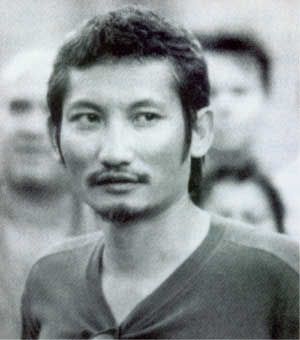

By Michael Wells
If you want to get an overview of Hong Kong cinema of the last quarter century - and who doesn’t? - you would do well to start by focusing in on Tsui Hark (“choy hok,” roughly). Tsui is a director, producer, occasional actor and the founding mogul, with wife Nansun Shi, of the production company Film Workshop. He has churned out a laundry list of hits, birthed and resurrected whole genres, presided over many of the industry’s modern technical advances and mentored other artists, like John Woo and Jet Li, to icon status. When he’s in the mood, he can also make a darn good movie.
Following is a highly personal and subjective partial catalog of the work of my favorite Asian filmmaker, with comments. It might grow and change as my knowledge and opinions do. It includes both Tsui’s work as a director and his equally important work as a producer, in which capacity, being a self-admitted control freak, he often serves as an unofficial co-director. Where Tsui produced, the director of record is noted.
Happily, the bulk of his films, like much contemporary HK film, are available in the U.S. with relative ease. Most can be found with English subtitles of varying quality and readability; look for these on DVD from many on-line DVD retailers. In addition, we’re seeing more HK movies released here in American editions packaged for roundeye consumption, including Tsui’s Zu: Warriors from the Magic Mountain, Once Upon a Time in China 1, 2 and 3 and Time and Tide.
For information and reviews on various DVD editions,
log on to AsianDVDGuide.com.
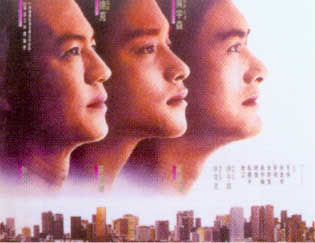
A Better Tomorrow II (’87) Director: John Woo. It’s fairly heretical, though not unprecedented, to prefer this sequel. Woo was reluctant to make it and disparages the end result, no doubt partly from bitterness over Tsui’s extensive interference. Sure, it’s gratuitous nonsense, going so far as to “resurrect” a slain character via a long-lost twin. But it’s the most purely entertaining of Woo’s major movies, somehow indulging in self-parody while retaining the sincerity of its macho sentimentality. (I actually misted up at one point.) The climactic, teeth-loosening gun battle with a mansion full of expendable Evil Henchmen deserves, I dunno, some kind of record. Or a trophy or a plaque. Something. You know the bit where two guys shoot each other simultaneously? Then one runs out of ammo? And the other guy tosses him a spare gun? How cool is that?! (And how Woo.)
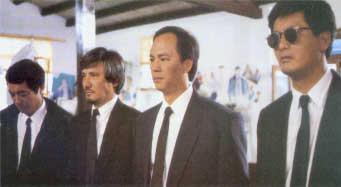
A Better Tomorrow III: Love and Death in Saigon(’89) There’s a story that Tsui once proposed making the original’s three leads female. He got a third of his wish three years later with the third entry, which he took over after a fed-up Woo walked. This prequel traces the reluctant initiation of Chow Yun-fat’s Mark into outlaw warriorhood at the side of a gun-toting tough chick, of the type Tsui loves and Woo would never allow to horn in on his hypermasculine world. He puts his stamp on Woo’s vision in other ways as well: the setting in the Vietnam War’s closing days speaks to both Tsui’s obsession with the specters of regional history and to his own origins in Vietnam, where he was raised by Chinese émigré parents. The whole project still can’t quite shake the question, “Why did we need this?” But it packs a surprising punch, especially if you remember what was happening that year in China. The same metaphor works for Bullet in the Head (’90), Woo’s alternate vision of a Vietnam-set ABT.
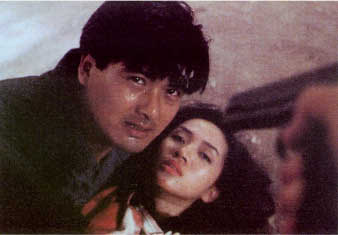
Black Mask (’96) Director: Daniel Lee. Perfunctory “wire fu” superhero stuff, with Jet Li trussed up as a genetically enhanced ex-soldier/guinea pig who does good while evading his government tormentors. At once lazy and frenetic (a feat, that), only middling action-wise and topped off with silly-looking titular facewear. It seems to hold considerable appeal for viewers who like anything that can be said to “rawk.”

The Blade (‘95) Tsui aims to strip off years of accumulated gloss to reveal the martial arts genre’s charred, gore-clotted heart in his uncomfortably feral screen-scorcher. It’s a little too wedded to the hoary conventions (quest to avenge father’s murder, hero who loses an arm and learns to fight anew, etc.) to succeed fully as a deconstruction. But it’s one of a kind and grows on me the more I see and think about it. Skull-rattling chaos is the (dis)organizing principle behind camerawork, editing and action choreography, to occasionally migrainey but often powerful effect – this is what it feels like to be in one of those acrobatic duels, a fraction of an inch or a slip of the foot away from grisly death.
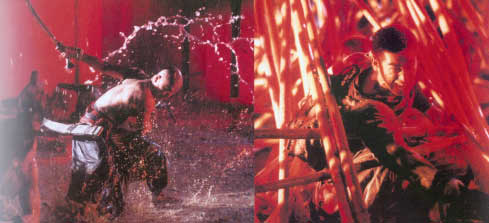
Burning Paradise (’93) Director: Ringo Lam. Lam specializes in gritty, street-level crime thrillers (City on Fire, Full Contact). The counterintuitive choice of director seems to have worked well for this kung fu period piece; it’s no The Blade, but it feels rougher and tougher than the fanciful oil slicks then standard in the genre. For one thing, it eschews wirework for most of the breathtaking acrobatics. The story is the one millionth offshoot of the “Shaolin Temple” legends about righteous warrior monks betrayed by one of their own and decimated by the imperial government.
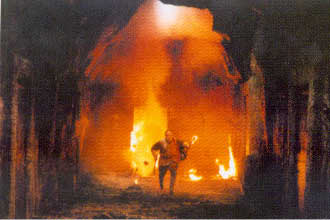
The Butterfly Murders (’79) I have a practically unwatchable copy of Tsui’s feature directing debut. It’s a period martial arts/murder mystery with sci-fi elements set largely in underground caverns. With butterflies. That’s what I’m told anyway; it’s hard to glean anything from those parts I tried to watch. “The most boring movie ever made,” asserted a fellow Tsui fan who’s seen it theatrically, and what I’ve seen seems to back up his word. In fact, if you’ve actually seen it and would care to contribute a real review blurb to replace this lame one, let us know.
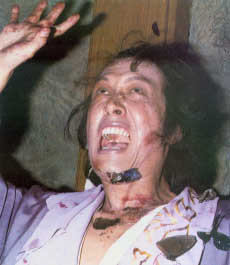
The Chinese Feast (‘95) This obnoxious “kung food” farce about a grand competition between master chefs is one of Tsui the director’s few real duds. It’s easy to see why he was interested, as he turns cuisine into an expression of the Chinese cultural identity he often explores. Much like the fights in a lot of martial arts movies, the cooking scenes are the real point, as hyperbolically kinetic and colorful as Peking opera. The shrill goofiness in between, though, grates like a bad night of comedy improv.
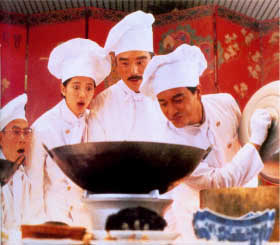
A Chinese Ghost Story (’87) Director: Ching Siu-tung. A milestone, not just because it brought back the ghost fantasy to haunt East Asian screens, updated for the Star Wars era of lavish special effects, zippy pacing and knowing humor. It’s also one of the most shamelessly entertaining movies ever made. Cantopop demigod Leslie Cheung is the wimpy scholar/tax collector who shacks up in a haunted temple with a beautiful phantom and faces demons, ghosts, zombies, magic swordsmen, disembodied heads, giant tongues, the King of Hell, et al. It’s well-nigh impossible to unravel the respective creative threads woven by Tsui and Ching; the latter has spent much of his career in the former’s shadow, despite being a true virtuoso in his own right. Regardless of who’s responsible, just when you think they can’t conjure up one more delirious hallucination or impossible visual invention, one more blossom of romantic poignancy or droll slapstick, they pull something else out of their bag of tricks.
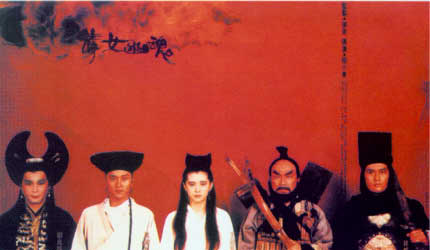
A Chinese Ghost Story II (‘90) Director: Ching Siu-tung. It sometimes clunks where the exquisite original glided, but you might be too busy gaping at the flying swords, gorgeous ghost women, giant centipedes and geysers of slime to notice. Free bonus: if you squint, you can see some allegory for post-Tiananmen political anxieties.
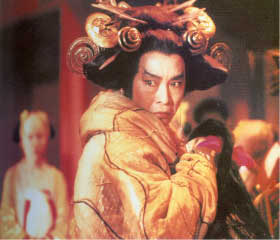
A Chinese Ghost Story III (’92) Director: Ching Siu-tung. A rerun, set rather arbitrarily a century later, with the vastly overqualified Tony Leung Chiu-wai in the inadvertently-heroic-naïf role. Ching and Tsui can still pull enough striking visuals and deft sight gags out of their sleeves to keep it from being a waste of time. Still, unless you’ve seen the original, like, ten times, you’re probably better off just seeing it again.
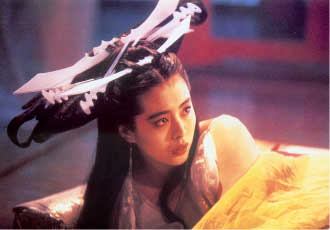
Double Team (’97, USA) An only half-hearted shot at the Hollywood big time – maybe Tsui knew that with stars like Jean-Claude Van Damme, Dennis Rodman (yep) and Mickey Rourke, this wasn’t exactly going to be Raiders of the Lost Ark. Van Damme and Rodman compete to see who can deliver the wincing jokey-macho dialogue with the most marble-mouthed uncharisma, while Rourke… well, who ever knows what he’s doing? The director does intermittently enliven this straight-to-video-worthy material with self-consciously nutty visuals and a few nifty action bits, but it mostly feels like effort wasted. Cultists like to complain that Tinseltown doesn’t know what to do with HK filmmakers, but I presume nobody forced Tsui into this at gunpoint.
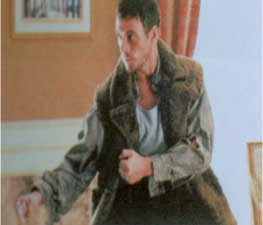
Dragon Inn (’92) Director: Raymond Lee. A marvelous exemplar of the early ‘90s vogue for wuxia pian (swordplay tales) that Tsui helped launch, set in an isolated desert inn where different factions of warrior-spies converge. It may be credited to Lee and based on a 1967 classic directed by the revered King Hu, but this is a Tsui production through and through. Best example: the quasi-striptease duel between Brigitte Lin (who’s disguised as a man) and Maggie Cheung, which ascends to dizzy and witty heights of the sexual ambiguity that so fascinates the producer. It’s pretty hot, too.
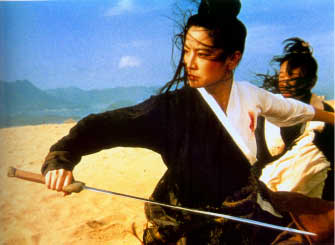
Green Snake (‘93) Impossibly radiant Maggie Cheung and nothing-to-sneeze-at Joey Wong play two female snake spirits who struggle to become human and find they’re more woman than the mortal world can handle. This intoxicatingly strange and sexy revision of an oft-told Chinese fairy tale foregrounds Tsui’s ambivalence towards sexuality and his cynicism about religion. The look is unique among HK fare, its images seemingly carved from pastel-hued quartz. Faced with this splendor, Western commentators tend perversely to zero in on some embarrassing FX work. But that just points up the director’s visionary ambition: he pushes his industry’s possibilities beyond their limits.
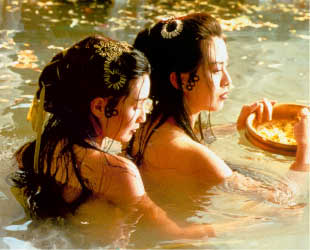
Iron Monkey (’93) Director: Yuen Wo-ping. This loose prequel to Once Upon a Time in China features a boy Wong Fei-hung (played by a girl) and a noticeably lower brow than its companion piece; a fan favorite, it feels pretty rote to me. Yuen is one of the industry’s martial arts directing legends, but I find his wire fu work uneven – here, it’s sometimes dazzling and sometimes awkward (especially the overabundance of action obviously speeded up by undercranking the camera). There isn’t much else to comment on – it’s pretty content-free.
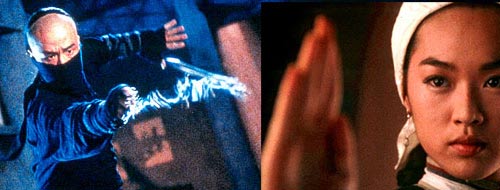
The Killer (’89) Director: John Woo. The last Tsui/Woo collaboration, the ultimate Woo ammo opera and the founding film of the Hong Kong action movie cult in the West. Nobly guilty hitman Chow Yun-fat and nobly world-weary cop Danny Lee find they have a lot in common. For instance, they’re both really, really noble. Killer enshrines men of violence who uphold chivalric honor in a heartless modern world (“A Pair of Blood-Spattered Heroes,” states the Chinese title). This, of course, bears as much relation to ethical reality as the shootouts do to physical and medical reality. But Woo expresses his vision so passionately that he can get away with it. His dramatic and cinematic hyperbole is an acquired taste, and if you acquire it, you’ll love this gorgeous, blood-spattered flick like your worn old teddy bear.
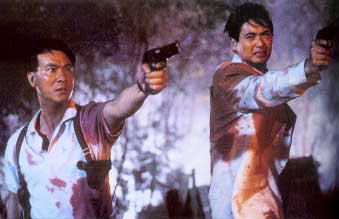
Knock Off (’98, USA/HK) It seems a touch too generous to say that Tsui’s second collaboration with Jean-Claude Van Damme is “better" than Double Team. But the critics who dismissed it as routine trash had their blinders on. This is a hoot, the weirdest approximation of an American-style action movie I’ve seen in a blue moon. Steven DeSouza’s hopeless script entangles a Hong Kong-based fashion counterfeiter in an unmemorable plot involving the Russian mob, CIA rogues and exploding kewpie dolls. Tsui succeeds this time in burying the cheese deep beneath an avalanche of absurdly showoffy, possibly self-mocking flourishes, such as digitally simulated, impossible “shots” inside cell phones and shoes and the like. (In retrospect, it looks like a dry run for the even more insane Time and Tide.) Dropped by probably bewildered Columbia suits into theaters with less marketing than some garage sales, it has all the makings of a cult classic. But since J.C. is on the box cover to scare away hipsters, I’m not holding my breath.
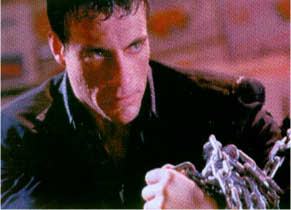
The Legend of Zu (’01) Tsui aims again to expand genre boundaries in this FX fantasy, a loosely related companion piece to his groundbreaking ’82 Zu: Warriors from the Magic Mountain, about cosmic warfare between mystical martial arts sects and an apocalyptic supernatural force. To my knowledge, HK popular cinema has never produced anything of this near-Tolkienesque scale and scope (explanatory titles like “200 years later” pop up), and I could practically feel Tsui spraining ligaments trying in vain to make it a masterpiece. The wall-to-wall digital effects, state of the art in HK, are TV level for Hollywood – Tsui, though, mostly manages to bypass issues of “realism” in favor of feverish visual poetry in pop-off-the-screen comic book colors. More problematic is the script, a dense thicket of tone-deaf exposition that needs three or four hours to breathe but suffocates at just over100 minutes. Picking on the actors for being wooden feels a little unfair in this context. So does picking on Miramax Films for their heavily cut and now-shelved version, Zu Warriors - it’s difficult to see what any U.S. distributor could have done with this in any form. There are enough remarkable moments and sights to make it well worthwhile for hardcore Tsui/wuxia fans, but the casual American viewer would likely only be confirmed in his low estimate of such fare.
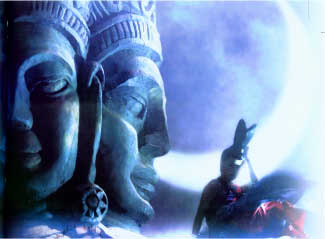
Once Upon a Time in China (’91) In many ways the central work of Tsui’s career, the OUATIC series reinvigorated the historical kung fu movie, portrayed more explicitly than ever the director’s concern with Chinese history and nationalism and conferred supernova status on up-and-coming powerkicker Jet Li. The story reimagines 19th century folk hero Wong Fei-hung, the most frequently portrayed personage in Chinese-language cinema, and plunges him headlong into the upheaval of China’s encounter with Western colonialism. For all its “masterpiece” rep, this first chapter is less successful than the two following – overstuffed and rather diffuse in its storytelling, with too many awful Caucasian bit players spouting bad cookie cutter English. [I should note that this refers to the commonly available, two-hour plus “director’s cut” - which, according to some sources, contains substantial material that Tsui didn’t want included but was contractually unable to keep off the video release.]
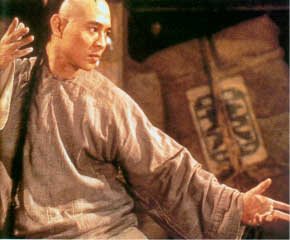
Once Upon a Time in China II (’92) Tsui deepens and qualifies his vision of cross-cultural conflict in one of the richest and most rewatchable martial arts sagas I’ve seen. Reluctant warrior Wong Fei-hung finds himself embodying Confucian moderation and virtue in the face of duplicitous Chinese officials and a murderous anti-Western cult, as well as the usual imperialist Europeans. This is a rare historical/polemical drama that you can gobble up like candy, in large part because the fight scenes kick ass all over the damn place.

Once Upon a Time in China III (’92) Jet Li’s athletic prowess needs no further acclaim, but he doesn’t get enough credit for the subtle grace of his characterization of Wong. He’s especially touching here, his righteously repressed shell softening beneath the glare of his love for Westernized childhood sweetheart “Aunt” Yee. Their slow-burn romance echoes the theme of a larger clash/accommodation between traditional Chinese values and modern Western ones, which only makes it more affecting. And easier to write pompously about. Have I mentioned the fight scenes kick ass?
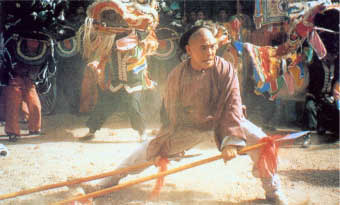
Once Upon a Time in China IV (’93) Director: Yuen Bun. It’s telling that our man passed on the directing chores: after the initial trilogy, the rest of the series is basically superfluous, and not just because Jet Li bailed after a dispute of the kind that seems to happen around Tsui. With the themes and emotional arcs pretty complete already, OUATIC IV seems little more than a box office-mandated formality, albeit a diverting one. The agile but less charismatic fighter Zhao Wen-zhou (aka Chiu Man-cheuk) takes over the lead and facilitates some good ass-kicking.

Once Upon a Time in China V (’94) The appearance of a wooden chest full of severed fingers in the first scene points, as it were, to where Tsui is taking this one: straight over the top. V is no more relevant than IV (the plot, for the record: pirates, yadda, yadda). But irrelevance is less relevant when you’ve got such gibbering mad fun to compensate. Tsui and fight choreographer Yuen Bun take the action into new realms of intricacy and furious speed (even slyly mixing in some pseudo-John Woo gunplay). Which is another way of saying it kicks your ass ‘til you can’t sit down.
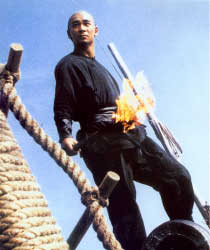
Once Upon a Time in China and America (’97) Director: Sammo Hung. In some ways, it’s a logical endpoint for the series: Master Wong in the Wild West. The true raison d’etre, though, is Jet Li’s return to the part, battling bad American accents and some greasepaint Indians out of a middle school production of Peter Pan. The strong resemblance to the 2000 Jackie Chan vehicle Shanghai Noon may not be coincidental: Chan had been mulling over such a premise for years and claims that former collaborator and buddy Hung filched it. Yet another reason all involved would have been better off skipping this exhausted final trudge through the mythology.
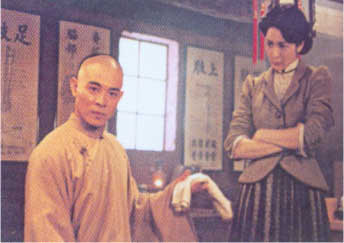
Peking Opera Blues (‘86) The One. The jewel in Tsui’s crown and a permanent member of my Desert Island Dozen, a big-hearted, wide-eyed adventure/comedy/melodrama starring the industry’s most popular actresses of the day, Brigitte Lin, Sally Yeh and Cherie Chung. The mismatched heroines ride a wave of upheaval in early 20th century China, more or less stumbling through espionage and revolution amid the clutter backstage in a Peking opera troupe. With its references to “democratic revolution,” is it a little poke in the eye to the impending Chinese communist regime? Even if it is, Mao himself could scarcely dislike anything this light on its feet, this brimming with grace and good humor. The abominable subtitling galls more every time I see it, but someone will fix that someday. Even with this deadweight, POB soars so effortlessly that when I recall it, my mind’s eye sees the characters floating just above the ground. Sometimes I think I dreamed the whole thing.
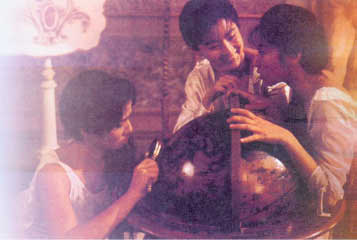
Shanghai Blues (’85) Mistaken identities, romantic mismatches and showbiz dreams, with the glamorous and squalid hubbub of post-WWII Shanghai as a fascinating backdrop. One of Tsui’s few non-action-or-fantasy works to gain a real following in the West, this fleet-footed farce is an homage to the pre-WWII Shanghai cinema that was the wellspring of Hong Kong’s. I know this because some film scholars say so in their books, not because I’ve seen any pre-WWII Shanghai cinema. To my blue eyes, its affinity with the following year’s Peking Opera Blues is more obvious. Both movies have a charmingly scatterbrained Sally Yeh, a more warmhearted tone than typical for Tsui, supporting characters that leap in and out of the movie like puppets on strings. Above all, they have the director’s split-second visual wit and grace operating at full luminescence. Here, his use of color, cutting, the edges of the frame and the placement of people in it, matches the classic Hollywood musicals. In fact, more than any other Tsui work, this one makes me wish he would direct an actual musical. He’s revivified practically every other genre – so why not?

Shanghai Grand (’96) Director: Poon Man-kit. Routine if well-wrought bauble about underworld grit and glamour in 1930s Shanghai, the “Paris of the East.” Pop music heartthrobs Andy Lau and Leslie Cheung are the buddies turned mortal enemies… over a dame, of all things! The Tragedy Lite of their story is just an excuse for decadent glitter, some surprisingly fierce and exciting action and a little subtextual nostalgia for the bygone days when the city was the movie capital of the Chinese-speaking world. Nice work, but a day later I barely remembered having seen it.

The Swordsman (‘90) Credited director: King Hu. Directors: Tsui Hark, Raymond Lee, Ching Siu-tung. Tsui designed this as a comeback vehicle for Hu, pioneering ‘60s/’70s maker of elegant swordplay movies. But the producer’s knack for driving away collaborators quickly asserted itself. That didn’t stop this lavish saga of Ming Dynasty factions battling over a “Sacred Scroll” from being a trendsetting success. Given its history, the style is surprisingly coherent (by HK standards), from the yellow-orange glow of lamplit interiors to the cobalt blue of nighttime forests to the eyeblink editing of combat scenes. You practically need Cliffs Notes and a slo-mo button to keep up, but your spinning head is part of the fun.

The Swordsman II (‘92) Director: Ching Siu-tung. The fascination with gender-bending shared by Tsui and the martial arts genre in general reaches its lunatic ne plus ultra in this superior sequel. Boyish hero Jet Li falls for a power-mad, transsexual warrior eunuch played by ice queen Brigitte Lin (who could hardly look more stunningly feminine). Their doomed romance, poignant for all its absurdity, powers this operatic fever dream as much as does the surreal wire fu. Good thing, too, since on first viewing the plot is indecipherable, partly because the characters from the first film are mostly played by different performers.
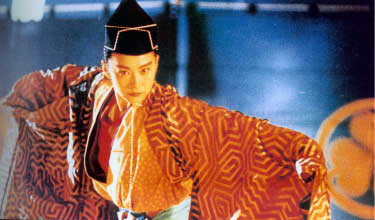
Seven Swords (‘05)
Tsui remade the wuxia genre in his image during Hong Kong cinema’s
last heyday, and I get the feeling that in this post-Crouching Tiger era,
as others take the leading edge... well, he’s jealous. Or if you
were more cynical, you might think he’s trying to ride a trend to renewed
box office glory, but if that were his main motivation, he’d probably be
making ghost movies. (Actually... that might be cool.) Either
way, in The Legend of Zu and now this film, we see him laboring mightily
to outdo everyone else currently playing the flying swords game, as well
as his younger self. It’s a fool’s errand, but he does get better
results here than in LOZ, even if it is, again, hardly the classic he wants
it so badly to be. There are too many major characters for most of
the melodrama to register, even at two and a half hours; Tsui has muttered
about a four hour director’s cut, but I’m not sure that would be preferable
– whatever his strengths, he’s no Kurosawa. Scattered grace notes
can be heard above the din. In particular, various relationships
around Kim So-yeon’s tragic Korean slave woman are sometimes touching,
and Sun Hong-lei’s deliciously wry performance almost makes a human out
of the monstrous villain “Fire-wind.” The spectacle, of course, is
the real point, and there’s little to complain of there. Tsui refreshingly
eschews digital crap, getting back to basics while amping them up with
his access to the screen-filling landscapes of mainland China (something
I still find slightly jarring to see in a movie like this, not having followed
the HK cinema of the new century very closely). Old school kung fu
master Lau Kar-leung’s swift, hard, only moderately-wireworked action choreography
seems almost radical in its traditionalism, and by the debased standards
of today, kicks ass quite thoroughly. Overall, this is just good
enough for me to hope that the sequel Tsui announced in February ’06 actually
gets made – although I’m not sure we need to see the entire series of seven
movies he reportedly dreams of.
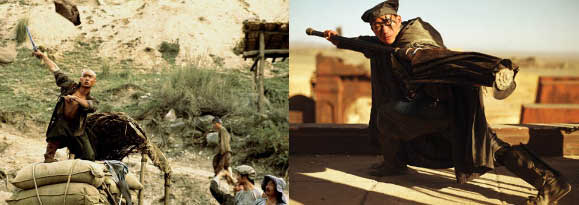
Time and Tide (’00) Tsui’s first directing effort for the home team in over four years disheartened many fans pining for the elegance and emotional/historical heft of his finest work. In outline, it’s generic gun fu about male bonding and violent redemption among underworld types. It don’t mean a dang thing and makes hardly a lick of sense. It’s shot and edited like an epileptic seizure on absinthe: shakey-cam, splashes of digital graffiti, where-the-heck-are-we-now whiplash transitions. And it’s a joy. Rarely has this director’s sheer delight in movement, color and the rubbery possibilities of state-of-the-art cinema been clearer. And pop heartthrob Nic Tse’s calm, cocky naïf is the perfect center for all the chaos. I backflipped out of the theater and couldn’t sit still for a half hour. Try arguing with that.
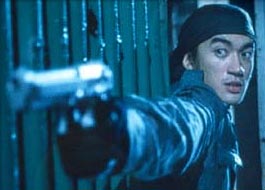
Twin Dragons (’92) Directors: Tsui Hark & Ringo Lam. Here, we have benefit concerts; there, they have benefit movies. Dashed off as a fundraiser for the Hong Kong Directors’ Guild, this contemporary kung fu farce stars Jackie Chan as long-lost twins (are you laughing yet?) and features a who’s who of local filmmakers in bit parts. Enough good action slapstick to make it worthwhile for Chan diehards (guilty!), but otherwise pretty tacky and less than pretty funny, with no hint of either director’s voice. That said, Tsui’s cameo, as a determined card cheat, is one of the movie’s best.
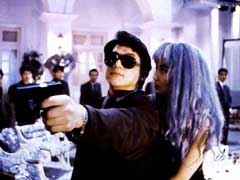
We’re Going to Eat You (‘80) Tsui’s sophomore, not to say sophomoric, effort is a kung-fu-cannibal horror/comedy that’s rarely seen in the U.S. Just about as crude and grotesque as the title implies, it’s delightful in its way, displaying a certain icky inspiration and brimming over with the gonzo energy he would subsequently polish. Local intellectual critics detected some satire of HK sociopolitics, anointed the pup a daring maverick and embraced him. A few movies later, they decided he was a vulgar populist and turned on him. Does that mean they considered this an art film?
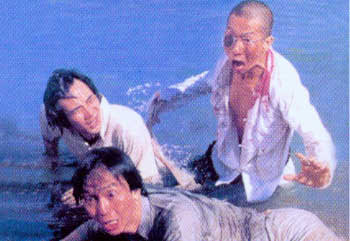
Wicked City (‘92) Director: Peter Mak. Live-action adaptation of the Japanese animation feature, set in a near-future Hong Kong where humans and semi-reptilian humanoids from another dimension co-exist uneasily. The potential of the premise goes largely unrealized in a mildly entertaining but half-baked oddity. The more far-out action scenes probably played better animated; here, they seem funnier than they’re meant to. The most intriguing element is venerable Japanese legend Tatsuya Nakadai slumming in a supporting role. Of course, you can always dig for metaphors about Hong Kongers’ identity crisis vis-à-vis the Chinese motherland. That, however, raises the question, what did it mean in Japan?
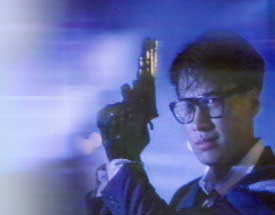
Zu: Warriors from the Magic Mountain (’82) An intermittently dazzling rough sketch for the action and fantasy elements in Tsui’s subsequent career, based on Chinese author Huanzhouluzhou’s classic novel of martial arts mysticism in a subterranean world of warring sects and supernatural beasts. Tsui imported technicians from America to help him advance Asian special effects by at least ten bounds in one film. Possibly the fastest-paced movie I’ve ever seen, it looks and feels like a surrealist parody of Technicolor fantasy films from the ‘50s, piling setpiece upon setpiece until the narrative is squashed into nothingness under their weight.
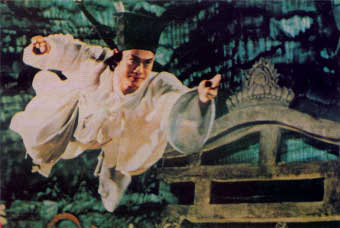
Zu Warriors (’01) See The Legend of Zu.
Michael Wells can be contacted here.